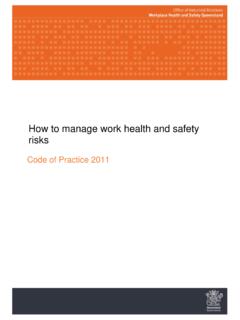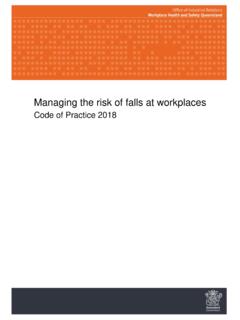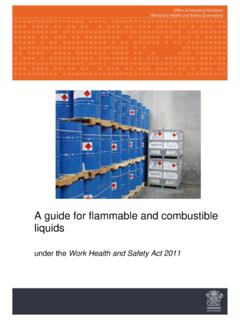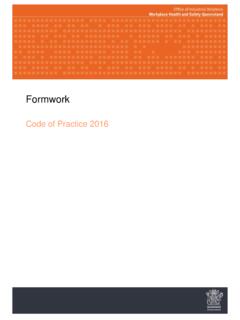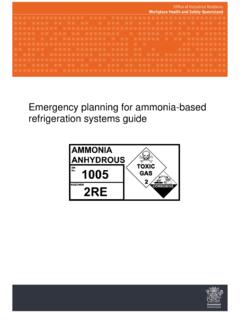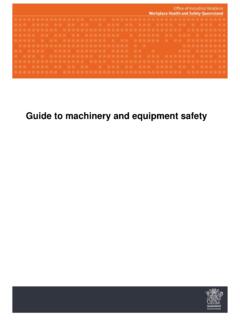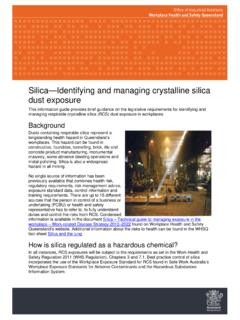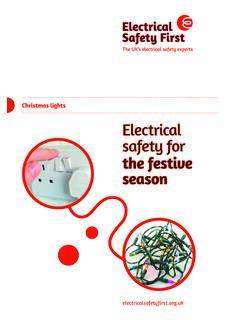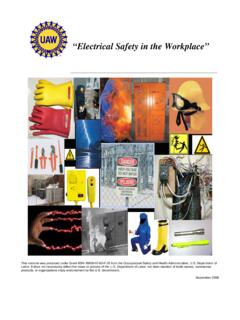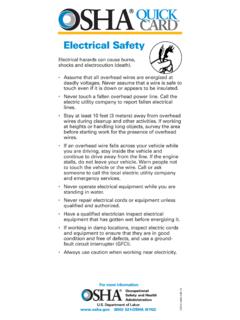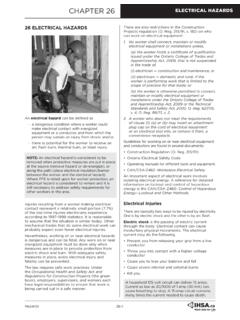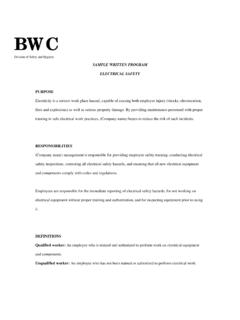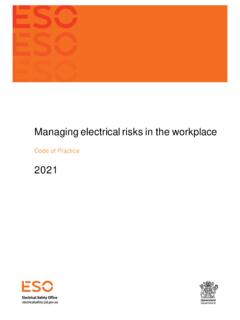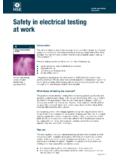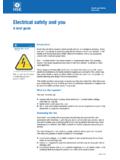Transcription of Electrical safety code of practice 2020 - Works
1 Electrical safety Code of practice 2020 Works Electrical safety Code of practice 2020 Works (ESOPDF028) Page 2 of 26 This Queensland code of practice has been approved by the Minister for Education and Minister for Industrial Relations under section 44 of the Electrical safety Act 2002. This code commenced on 2 January 2020. ESOPDF028 The State of Queensland 2020 Copyright protects this document. The State of Queensland has no objection to this material being reproduced but asserts its right to be recognised as author of the original material and the right to have the material unaltered. Electrical safety Code of practice 2020 Works (ESOPDF028) Page 3 of 26 Contents Legislative framework.
2 5 Foreword .. 5 Scope and application .. 6 What is the Works of an electricity entity? .. 6 What is an electricity entity? .. 6 1 Introduction .. 7 What are Electrical risks? .. 7 Who must manage Electrical risks? .. 7 What is required to manage the Electrical risks? .. 8 Information, training, instruction and supervision .. 9 2 The risk management process .. 9 Identify the hazards .. 9 Assess the risks .. 10 Control the risks .. 10 Review the control measures .. 11 3 Protective earthing .. 11 Scope .. 11 Requirements under the Electrical safety Regulation 2013 .. 11 Earthing system requirements .. 12 The Multiple Earthed Neutral (MEN) system .. 12 Earthing of LV distribution centres.
3 13 Exposed conductive parts within above ground associated with high voltage in a MEN system .. 13 The Common Multiple Earthed Neutral (CMEN) system .. 13 Earthing at a distribution centre (CMEN) .. 14 Exposed conductive parts within above ground associated with high voltage in a CMEN system .. 14 The Single Wire Earth Return (SWER) system .. 14 Exposed conductive parts within above ground associated with high voltage in a SWER system .. 15 Exposed conductive parts that may reasonably be expected to become energised from the electricity supply system if there is an insulation failure or contact with a conductor, should be insulated. 15 Earthing of high voltage distribution centres.
4 15 Exposed conductive parts within above ground associated with high voltage transmission systems .. 15 Exposed conductive parts within above ground associated with low voltage only .. 15 Induced voltage on the sheath of underground electric lines .. 15 Exposed conductive parts higher than above ground .. 15 Earthing Conductors .. 16 Minimum size of earthing 16 Materials for earthing conductors .. 16 Mechanical protection of earthing conductors .. 16 Materials for earthing 16 Test links .. 16 Earth fault currents .. 16 Prospective touch and step voltages .. 16 Prospective touch voltages special locations .. 16 Prospective touch voltages frequented locations.
5 16 Remote locations .. 16 Prospective step voltages .. 17 Testing and maintenance of earthing systems .. 17 Electrical safety Code of practice 2020 Works (ESOPDF028) Page 4 of 26 Relevant Documents .. 17 4 Design and installation of underground electric cable systems .. 17 Scope and application .. 17 Compliance with Standards .. 17 Selection of cables .. 18 General .. 18 Conductors .. 18 High voltage cables .. 18 Low voltage cables .. 18 Neutral connections .. 18 Route selection .. 18 Installation .. 19 General .. 19 Cable depths .. 19 Laying of cables .. 19 Separation of cables .. 19 Protection of cables .. 19 Identification of underground cables.
6 19 Protection general .. 20 Protection mechanical .. 20 Protection above ground .. 21 Protective earthing of cables .. 21 Records .. 21 References .. 21 Cable selection .. 21 Route selection and cable selection accessories .. 22 5 Maintenance of supporting structures for lines .. 22 Scope and application .. 22 Serviceability determination .. 22 Frequency of inspection .. 23 Marking of poles .. 23 General .. 23 Marking scheme .. 23 Removal of markings .. 23 Resultant action and timeframes .. 23 Pole records .. 23 Appendix A Meaning of terms used in this code .. 24 Electrical safety Code of practice 2020 Works (ESOPDF028) Page 5 of 26 Legislative framework The Electrical safety Act 2002 (the ES Act) is directed at eliminating the human cost to individuals, families and the community of death, injury and destruction that can be caused by electricity.
7 The ES Act establishes a legislative framework for preventing persons from being killed or injured by electricity, and preventing property from being destroyed or damaged by electricity. The ES Act places the primary Electrical safety duty on a person conducting a business or undertaking, who must ensure the business or undertaking is conducted in a way that is electrically safe. Duties are also placed on officers of a person conducting a business or undertaking, workers and other persons at a workplace, as well as electricity entities, designers, manufacturers, importers, suppliers, installers, repairers and persons in control of Electrical equipment. The Work Health and safety Act 2011 (WHS Act) requires persons who have a duty to ensure health and safety to manage risks by eliminating health and safety risks so far as is reasonably practicable, and if it is not reasonably practicable to do so, to minimise those risks so far as is reasonably practicable.
8 The WHS Act provides a framework to protect the health, safety and welfare of all workers at work. It also protects the health and safety of all other people who might be affected by the work. The WHS Act places the primary health and safety duty on a person conducting a business or undertaking, who must ensure, so far as is reasonably practicable, the health and safety of workers at the workplace. Duties are also placed on officers of a person conducting a business or undertaking, workers and other persons at a workplace. In terms of Electrical safety , where the ES Act and the WHS Act both apply, the ES Act takes precedence. Foreword This Code of practice on how to manage risks associated with electricity entity Works is made under section 44 of the ES Act.
9 A code of practice is a practical guide to achieving the standards of Electrical safety required under the ES Act and the Electrical safety Regulation 2013 (the ES Regulation). A code of practice applies to anyone who has an Electrical safety duty in the circumstances described in the code. In most cases, following a code of practice would achieve compliance with the Electrical safety duties in the ES Act, in relation to the subject matter of the code. Like regulations, codes of practice deal with particular issues and do not cover all hazards or risks that may arise. Health and safety and Electrical safety duties require duty holders to consider all risks associated with work, not only those for which regulations and codes of practice exist.
10 Codes of practice are admissible in court proceedings under the ES Act and ES Regulation. Courts may regard a code of practice as evidence of what is known about a hazard, risk or control and may rely on the code in determining what is reasonably practicable in the circumstances to which the code relates. Compliance with the ES Act and ES Regulation may be achieved by following another method, such as a technical or an industry standard, if it provides an equivalent or higher standard of Electrical safety than the code. An inspector may refer to a code of practice when issuing an improvement or Electrical safety protection notice. Electrical safety Code of practice 2020 Works (ESOPDF028) Page 6 of 26 Scope and application This Code gives practical advice on ways for an electricity entity to manage Electrical safety risks associated with earthing systems, underground cable systems, and supporting structures for overhead lines forming parts of the Works of an electricity entity.
